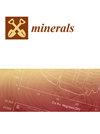重访希腊伯罗奔尼撒半岛东南部莫莱隐伏锌-铅±(银、锗)VMS 型矿藏
IF 2.2
4区 地球科学
Q2 GEOCHEMISTRY & GEOPHYSICS
引用次数: 0
摘要
伯罗奔尼撒半岛东南部隐蔽的莫莱锌-铅±(银、锗)层状矿床赋存于三叠纪中间凝灰岩、火成岩和次生安山岩流中。母岩显示了超俯冲带(SSZ)环境的微量元素特征。矿石形成分为三个阶段,第一和第二阶段与表生、层状、块状到半块状矿石的形成有关,第三阶段后期与脉状矿化有关。煤矸石绿泥石和闪石的 O 和 D 同位素地球化学显示,在晚期第二阶段热液活动的断乳期,由于热液系统的隆起,煤矸石绿泥石和闪石与新鲜的陨石水混合。闪锌矿是主要的矿相,在第一阶段(Sp-I)和第二阶段(Sp-II 和 Sp-III)形成了三种不同的品种。所有闪锌矿品种共存,表明成矿流体的化学性质在逐渐变化。莫莱矿石的特点是银和锗含量较高。四面体是主要的银载体,而在三个闪锌矿品种中,早期 Sp-I 的 Ge 含量最高。莫莱锌-铅±(银、锗)矿床的特点是介于双峰长晶块状硫化物和次生表生系统之间,其依据是形成深度较浅、存在与相分离相关的水力角砾岩、矿石沿高角度断层形成、地温测量得到的矿石形成温度相对较低,低于 250 °C,以及不存在双峰长晶型矿石的典型结构。本文章由计算机程序翻译,如有差异,请以英文原文为准。
Revisiting the Concealed Zn-Pb±(Ag,Ge) VMS-Style Ore Deposit, Molai, Southeastern Peloponnese, Greece
The concealed Molai Zn-Pb±(Ag,Ge) stratiform deposit in southeastern Peloponnese is hosted in Triassic intermediate tuffs, ignimbrites and subaerial andesitic flows. The host rocks display trace element signatures of a Supra-Subduction Zone (SSZ) setting. Three ore-forming stages are recognized, with stages I and II related to formation of the epigenetic, stratiform, massive-to-semi-massive ore and a late stage III associated with vein-type mineralization. The O and D isotope geochemistry of gangue chlorite and epidote reveal mixing with fresh meteoric water during the weaning stages of the hydrothermal activity of the late stage II due to uplifting of the hydrothermal system. Sphalerite is the major ore phase, with three different varieties formed during stages I (Sp-I) and II (Sp-II and Sp-III). All sphalerite varieties coexist, depicting gradual change in the chemistry of the ore-forming fluids. Molai ores are characterized by elevated Ag and Ge contents. Tetrahedrite is the major Ag carrier, while among the three sphalerite varieties, early Sp-I comprises the highest Ge contents. The Molai Zn-Pb±(Ag,Ge) deposit is characterized by intermediate features between bimodal felsic massive sulfides and subaerial epithermal systems based on the shallow formation depth, the presence of hydraulic breccias associated with phase separation, the ore formation along high-angle faults, the relatively low ore-forming temperatures below 250 °C obtained from geothermometry, and the absence of the typical structure of bimodal felsic type ores.
求助全文
通过发布文献求助,成功后即可免费获取论文全文。
去求助
来源期刊

Minerals
MINERALOGY-MINING & MINERAL PROCESSING
CiteScore
4.10
自引率
20.00%
发文量
1351
审稿时长
19.04 days
期刊介绍:
Minerals (ISSN 2075-163X) is an international open access journal that covers the broad field of mineralogy, economic mineral resources, mineral exploration, innovative mining techniques and advances in mineral processing. It publishes reviews, regular research papers and short notes. Our aim is to encourage scientists to publish their experimental and theoretical results in as much detail as possible. There is no restriction on the length of the papers. The full experimental details must be provided so that the results can be reproduced.
 求助内容:
求助内容: 应助结果提醒方式:
应助结果提醒方式:


